Cat's Tongue Letter:
On series vs. singular works, on painting to the seasons, on the pleasures of an art practice, on the cat's tongue brush.
I
Art Process: On series vs singular works.
I remember visiting a gallery in Barcelona many years ago and attending an exhibition of Picasso where one gallery note observed that in preparation for one piece the artist had produced 84 studies.
This surprised me at the time but doesn’t surprise me so much now. I think back then I had had this impression of major works of art as singular, as “masterpieces” let’s say. Uncommon, pointed, focused, unprecedented. Or at least planned in a singular way much like the studios of earlier artists would work on a commission for a patron.
But now, just from observing more, at close hand, my own and other artists’ processes, I have a clearer sense of how works of art emerge. As often as not they seem to evolve out of a continuum of work, out of tests and trials, out of a series of variations on a theme. And so, there are artists who produce series of works with recurrent motifs, whether it be Picasso’s Blue or Rose period paintings, or Hockney’s swimming pools, or O’Keefe’s floral innards. And in some instances some artistic careers are built around a motif or motifs and so everything they do ends up being a variation on a theme.
And this knowledge is useful as it can adjust your sense of the importance of any piece you might produce to the extent that it allows you to be less inhibited by a dread of making mistakes or producing lesser work. Knowing that even major works in the past existed in a continuum of work should be sufficient permission to experiment and play even when intent on producing “serious” work.
And so everything I do these days I do with the knowledge that I am engaged in a sequence, whether long or short, thematic or material-based, and that each individual piece is just one part of it.
And this applies in relation to my own work. I worked in 2024 and early 2025 on a series of originals on paper across several months, and for the foreseeable future I will be working on canvas boards and gesso panels using acrylic.
And once again I shall be searching and testing via a series of interrelated works, step by step, piece by piece.
II
Art Adjacent: On painting to the seasons
There was a tendency in me when I began as an artist to simply follow the inspiration of the seasons year by year.
It made sense, even though I wasn’t exclusively a landscape artist, to draw and paint what was around me month by month. This is in tune with how many previous artists have worked after all. This is a natural approach to take as an urban artists or plein air artists and for more occasional or informal artists it makes sense to use your art as a journal of your daily lived experience. And so, as it seemed right and fitting to observe whatever was presented to me day in and day out, this is how I went on.
And it was valuable to do this to a point I feel. I am a sort of nature artist and as a nature artist (and as a human being) it is useful to do anything that connects or re-connects you intimately to the run and seam and stitch of daily life on this planet - how things unfold, summer turning to autumn and then darkening into winter and then lightening again into spring.
David Hockney talks about his C21st Yorkshire Normandy landscapes in this way and how committing to the discipline of them he felt a new awareness of the passage of each season and how it slowly and almost imperceptibly transitions stage by stage.
Nevertheless, I think of myself differently now and although any art discipline focuses awareness in a useful way I have felt occasionally confined by this approach. For instance, I found myself restricting myself to producing and sharing seasonal-appropriate pieces for some time. I think what freed me from this was setting myself my own projects and thinking more about what my art process meant to me and what my unique path should be. And these are all valuable questions for any artist to ask at any stage of their process I feel.
And so instead of continuing in my previous unthinking manner I stood back and decided on a particular emphasis of my own invention. Just because we might draw or paint or depict anything doesn’t mean we should.
I am curious to know if anyone else is or was following the seasons in their work or if they have chosen any other method or path for themselves?
III
Art Adjacent: On revisiting subjects OR How many studies are enough?
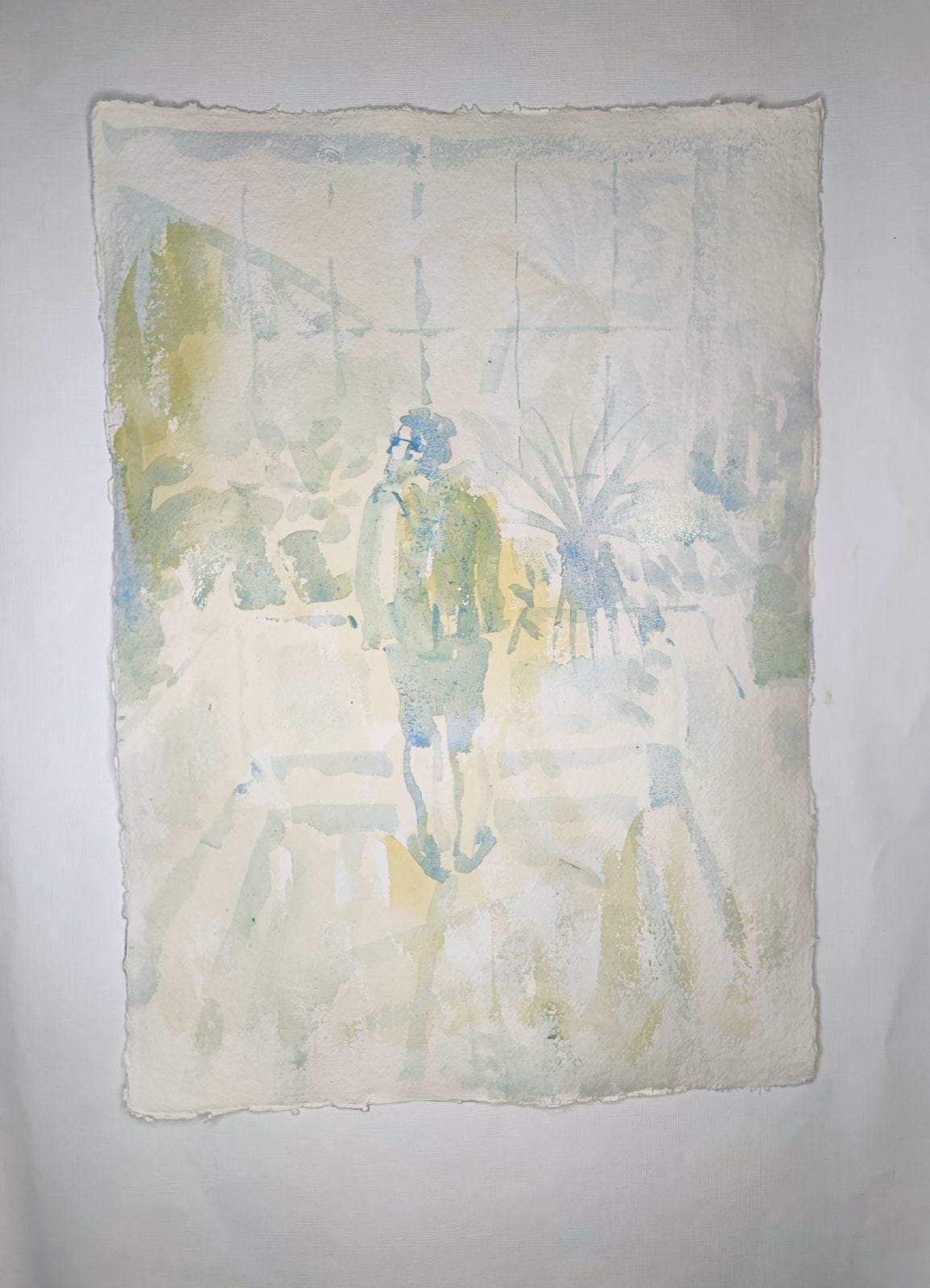
Its always interesting to observe particular artists’ obsession whether they be Degas’s ballerinas and racehorses, Picasso’s bulls and harlequins, Matisse’s balconies, Van Gogh’s wheat fields, the list goes on!
I’ve noted the same tendencies in contemporary artists whether they be fine art painters, or illustrators, instagram favourites or obscure. And certainly, of late, if you reviewed my 2024 instagram posts you would see definite recurrences and patterns. I am focused on certain subjects more and more and my recent posts are all variations on the theme of figure in a hothouse setting or something similar!
To me this is a not a regrettable development. I have found one of my ‘subjects’ effectively, and I feel my current run of pictures fulfils many of my interests in one gulp. But I also understand that browsers can often like variety (as I do myself) in other artists (sometimes). For instance, I am in awe of the versatility of illustators. They have to be able to depict anything and everything in multiple media, and invent and re-invent on the hoof. So a good illustrator is wonderful to follow as you can expect in many cases a display of maverick versatility that many other artists won’t attempt to emulate.
But when it comes to say, fine artists, and this is something of a generalisation, as what I’m about to say applies to illustrators too in some instances, I like a more singular and distinctive style. It can be a style that allows potentially for versatility of various sorts but preferably it will be focused in certain respects. It will have a shape to it and a distinct identity.
I say this because I admire artists and illustrators (who are of course also artists but I need to form a distinction to make my point), and feel that when I was starting out I was attempting to draw and paint everything in the manner of my notion of an exemplar all-rounder illustrator.
But now I attempt to cover less ground but with more focus, having identified, more or less, what interests me more.
And so instead of attempting range I attempt depth. I stay with subjects for longer. For every painting there might be several variations in different sizes, colours and media. I have a new appreciation and curiosity about the manifold possibilities of trying to do the same thing over and over but with variations. I want to know what it will be like if I do things slightly differently each time.
I suppose there is no one answer to the question: how many studies is enough? All I can say is that although every artist may differs on the extent to which they revisit subjects they all do to some extent. Revisiting subjects is part of the process and I note this mostly because in the past it wasn’t something I quite grasped. And so there is no clear answer to the question. But what we can say is that in most cases there will be and probably needs to some studies or sketches.
And in some instances those studies won’t just be ‘background’ work, they will be series or sequences, exhibition or front-line “serious” work. The real thing. The tension between what is background and foreground in any artistic process can be the motor that drives the work forward and the division between the two can often be slight or hard to distinguish.
IV Process Notes: On the Pleasures of an Art Practice
Lately, I have been trying to define the pleasures of an art practice. What is it that draws an artist back again and again to the work of creating art?
I can only suppose each artist has their own unique answer to that question. For me it is a number of things. And so, for instance, there are pleasures associated with working with each particular medium. With watercolour and gouache there are the pleasures of working in loose overspilling washes, observing the (semi) controlled chaos of how colours turn and change moment by moment. Transparencies. Glazes. Veils. With acrylic paint I enjoy the thicknesses of more plastic paint (in every sense) and making definite statements with grades of opacity.
In my dry media I enjoy using coloured pencils and crayons and markers, each again with their own unique kinetic spark. And in relation to coloured pencils: am I the only person who has some connection to them, possibly begun in childhood, where when I see them I think of playtime or some sort of extra-curricular lull in the day’s schedule. And they, out of everything, are to me perhaps the most beautiful art objects of all, the smell of them, the shape of them, paring them, their colours and textures on a page. There is a peculiar joy to them I can’t define or explain.
I feel this pleasure-tinged nostalgia to a lesser extent towards markers as they also connoted a break from school or home work and as they also possess the ready-to-hand immediacy of making colour of your choosing in the moment.
And making colour of your choosing in the moment is one of the key pleasures of art at any time or age, regardless of the medium. Here is a power of sorts, an extremely expressive power, that we can’t summon or command in any other circumstances.
And I suppose even the most developed artist has the urge of expression at the root of their practise even when it is scrambled up with other motivations and desires and life complications, and so let’s say for now that expression is the ultimate pleasure of any art practise, whenever pleasure exists.
V
Originals
I will be periodically showcasing small amounts of originals (five maximum) on Big Cartel, accessible via my bio in instagram (as part of my linktree) & here: Shop.
And if you are interested in pictures not currently listed I can add them to the store.
VI
On the Cat’s Tongue Brush
I have a fluctuating relationship with brushes.
I struggled with painting at first because I loved to draw primarily. That was my founding passion. And so when I picked up a brush I treated it like a pen or pencil and tried to draw with it and that doesn’t always work so well with every brush. And so I found most of the brushes I used difficult and gnarly and wrestled with them and rejected many of them.
The cat’s tongue brush is not a brush I’ve used that often but it is my entryway into this month’s consideration of brushes. For me it stood for another type of brush I didn’t know existed until recent years. In the specific case of the cat’s tongue brush I am still not sure what its potential might be but I remain optimistic. It is still a candidate for future use! When we begin painting there is much to learn - by doing principally. And much of that involves filtering - choosing and rejecting over and over again in the course of testing and trying.
And so , although the cat’s tongue brush I own is too large for a lot of the work I currently do it represents the type of brush I didn’t know existed before I began to paint and so I repeat it’s name in a non-expert way here because it reassures me as it is one of the (many) names of brushes that I searched for by asking over and over: “But what brush is good for drawing with?”
Which is of course an impossible and absurd and possibly insulting question to ask any painter as they are painters. They paint, they don’t draw!
I will report more on the actual unique properties of the cat’s tongue brush when it is properly tested by me but for now it has been put aside in the category of “drawing brushes”, the category I needed badly to transition into painting.
VII
A Reminder
If you have enjoyed any aspect of my monthly posts do consider liking, and subscribing to this newsletter. It would really mean a lot and help me maintain this space going forward
Finally if you like my artwork and want to support its continuance you might also consider a small paid subscription. It would be much appreciated so I can evolve and develop my practice. Many thanks.

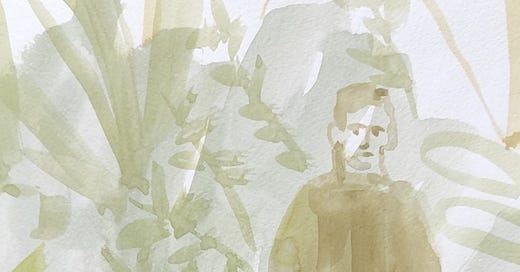



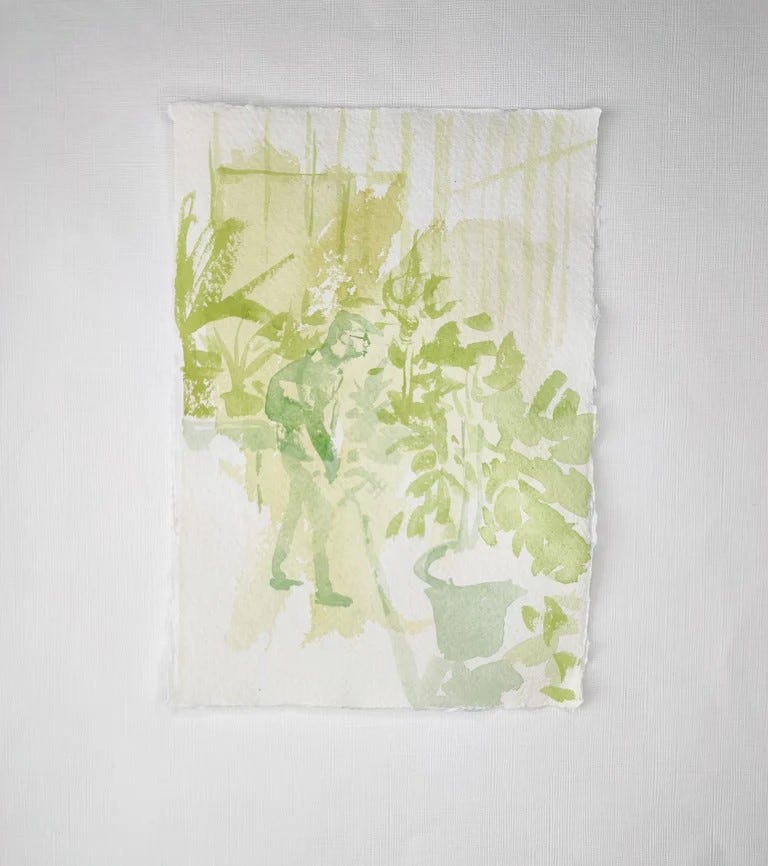
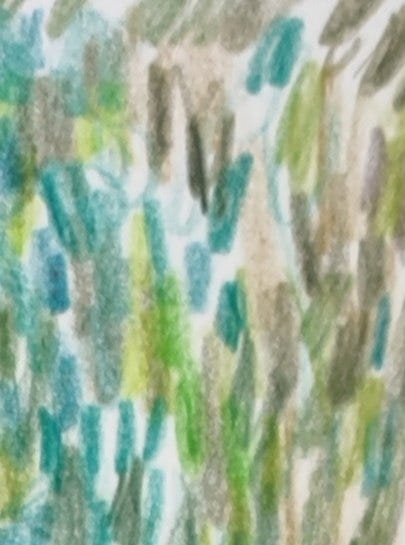
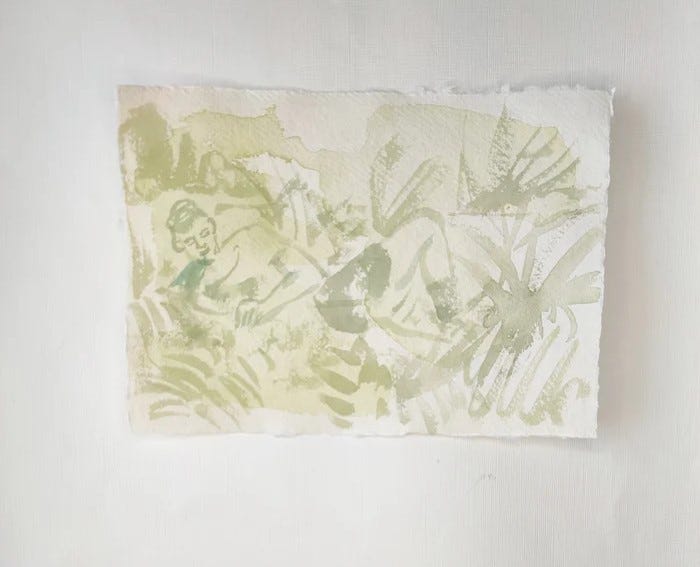
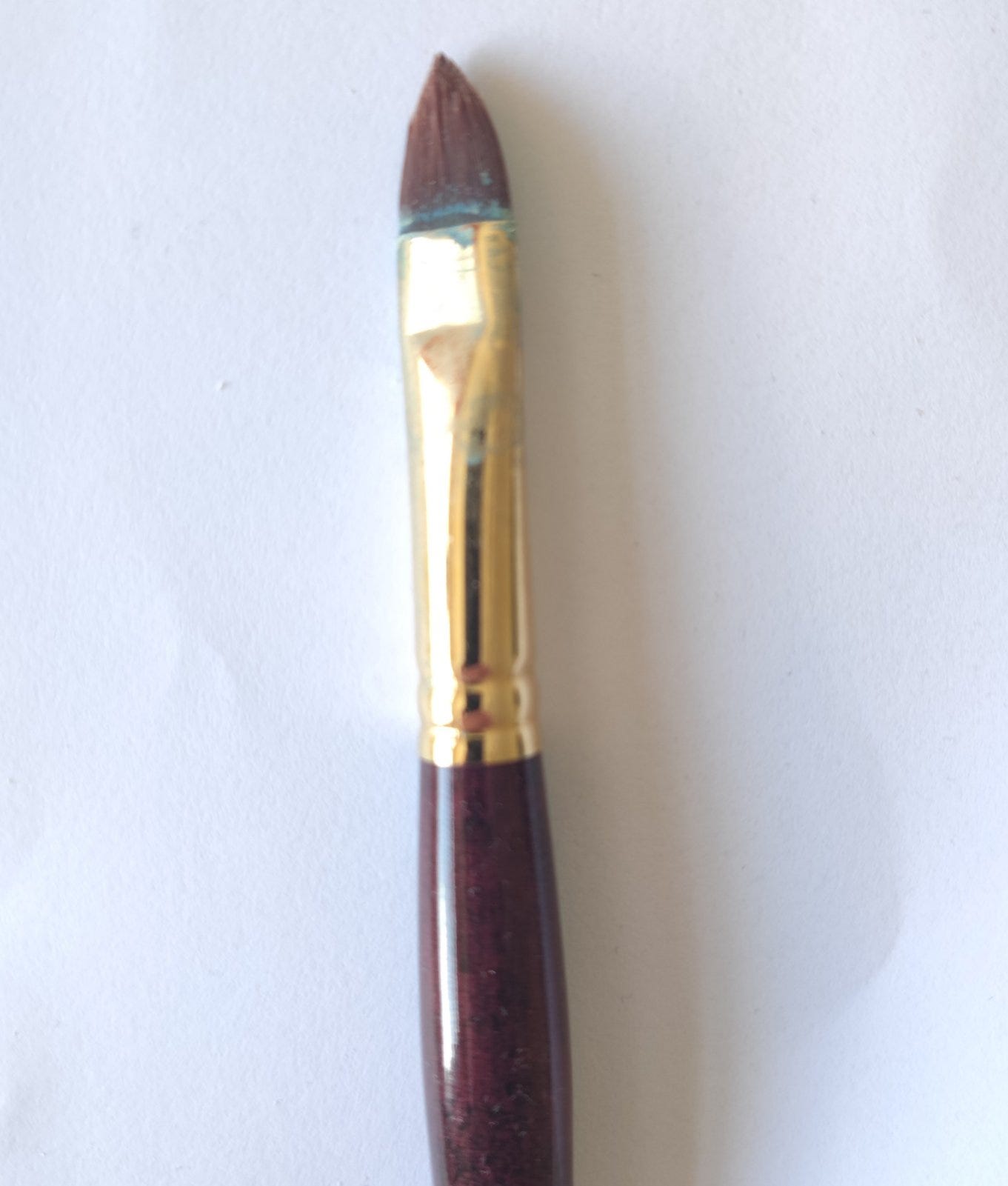
The wood/wax scent of a coloured pencil is one of the strongest amulets for childhood.